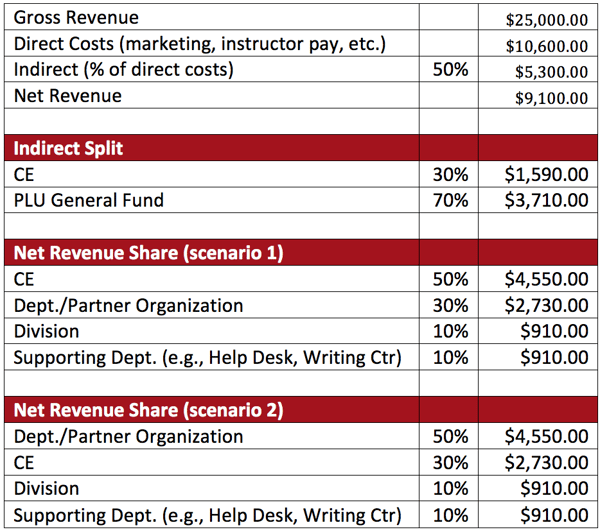Published on
Launching a New CE Unit: Setting the Groundwork

Since the first installment in this series went live in October 2014, Pacific Lutheran University (PLU) has made progress in identifying areas for advancing continuing education at our institution. The medium for this development has been the recommendations of a task force comprised of faculty and staff across schools and divisions.
Our Provost and Vice President for Academic Affairs established the Continuing Education Task Force in May 2014. The Provost asked the group to analyze PLU’s current organizational structure, policies and procedures, and financial model for continuing education and report back with recommendations for enhancing each area in order to generate new revenue for the university. In addition to reviewing internal reports and interviewing past and current staff and faculty involved with continuing education, the task force reviewed a number of sources, including institutional reports from a variety of universities and published works on the subject.
The group submitted nine recommendations to the provost in January of this year that addressed issues across the three categories mentioned above. Three of the nine will be highlighted here.
Recommendation: Establish a hybrid organizational model, whereby the central Office of Graduate Programs and Continuing Education (GPCE) partners with PLU’s schools and divisions to deliver continuing education and professional development courses, programs and events.
GPCE was established in February 2014. Current staffing in the GPCE office—which consists of my Associate Provost position, a Director of Graduate Admission, a Graduate Admission Specialist, a CE Program Manager, and two student workers—is insufficient to operate a centralized organization for CE programming.
We need to partner with the existing schools and divisions on the development, delivery and evaluation of CE products. Figure 1 below shows an example of the relational lines between the main GPCE office and other academic units, including existing CE programs under the School of Nursing (1.5 FTE staff for CE) and the School of Education and Kinesiology (1 FTE for CE).

The hybrid model reflects what actually exists at PLU. Responsibilities for running CE programs are shared between GPCE and the individual academic units. For example, GPCE oversees institutional policies and procedures, including the course proposal process, marketing campaigns, instructor agreements, course scheduling, registration and payment, and the like. The academic units typically assist with the recruitment and evaluation of instructors, compliance with accreditation standards, partnership development, and new content development.
It is anticipated that PLU will move toward a more centralized CE organization in the future, which would mean a re-allocation of resources of both staff and money. The purpose of such a move would be to increase the oversight of CE programs, reduce some overhead and enhance institutional strategic planning.
Recommendation: Implement an online content management system that can centralize course creation, scheduling, registration, payment and financial reporting for all PLU continuing education programs.
This recommendation would add significant value to both the existing hybrid organizational model and the future centralized structure for PLU’s CE efforts. The amount of staff time currently dedicated to administrative tasks is unsustainable given the institution’s plans for growth in CE offerings and enrollment.
Investing in a software system that would simplify the administrative process, especially for course registration and payment, would free up staff time for other student advising services and business development activities. The challenge for PLU is where to find the money for the initial investment.
GPCE will need to implement a scalable solution that builds up a reserve over time to address this necessary expenditure.
Recommendation: Adopt a budget model that establishes a consistent indirect cost rate and revenue share scheme.
The current budget system that PLU uses can be labeled as a “one bucket” system for collecting revenue and allocating funds for expenses. The system lacks transparency, as well as any incentive scheme for schools, divisions or external constituents to engage in collaborative CE programming. Implementing an indirect cost rate and revenue share model would enable GPCE to address overhead costs for the office and institution, as well as develop partnerships with PLU academic departments and external organizations and companies. Table 1 below proposes a financial model based on revenue and costs of a hypothetical course.

The direct costs would account for the development, promotion and delivery of the course. Indirect costs relate to those activities that support the above work, which are generally performed by numerous offices across campus. As shown in the model, the indirect is fifty percent of the direct costs, which reflects a similar rate negotiated by PLU for its federal grants. It is a rate that the task force thinks is sufficient for covering all relevant overhead costs. The model continues with a percentage split of the indirect in order to address both GPCE and institutional overhead. The fun part comes next in the table with the proposed net revenue share scenarios. The basic idea here is that the departments and offices directly involved with supporting the CE course (or program) should receive a percentage of the net revenue. Moreover, the department or office that does most of the work for delivering the CE product should receive the higher percentage.
PLU’s Provost has reviewed these three recommendations, along with the six others developed in the task force report. A decision has been made to begin implementing the recommendations in the next fiscal year, which for PLU begins June of this year. By this coming fall, I hope to return to the Evolllution community and offer another progress report. Let’s see where this goes.
This is the second installment of an ongoing series discussing the process of launching a CE unit at Pacific Lutheran University. See the introductory piece.
Author Perspective: Administrator



